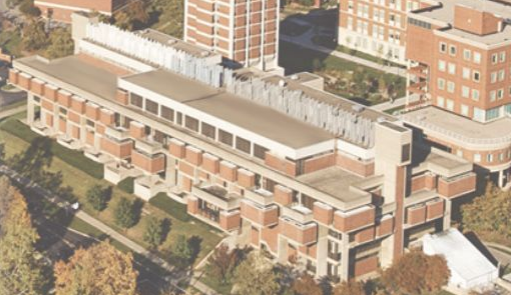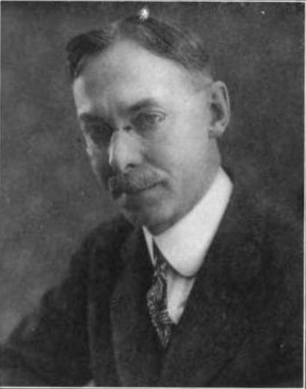
| River Campus | Hutchison Hall |
 |
| Hutchison Hall in 2012 |
 |
| Charles Force Hutchison |
Construction on a new Chemistry-Biology building began in August 1968. The building was partially occupied by late 1971 and fully occupied by its dedication in May 1973.
The new Carlson Sciences Library opened in 1972 on the plaza level, named after Chester Floyd Carlson. This library was moved to the new Computer Studies and Science Library building in 1987.
The building was named after Charles Force Hutchison in 1971. He was an 1898 UR chemistry graduate and worked with George Eastman at Eastman Kodak for over fifty years. Upon his death in 1974, Charles F. Hutchison bequeathed to the University of Rochester over $25 million "for present or future construction and for the maintenance thereof." It marked the single largest bequest received by any college or university in the previous five years and was one of the three largest ever received by the University of Rochester, after George Eastman's $55 million and $25 million given by Xerox chairman Joseph C. Wilson.
References
1932 "University
Elects Four to its Board of Trustees," Democrat and Chronicle,
June 29, 1932, Page 15.
Charles F. Hutchison
1968 "Going
up - Chemistry-Biology Building," Currents, August 14, 1968
Construction on the UR's new chemistry-biology building along River
Boulevard between Elmwood Avenue and Library Road will begin immediately.
Grading operations at the site are already under way.
The building, the second in the new River Campus science complex, was a
top-priority project in the University's recent capital campaign. The f
acility, expected to cost about $15 million,
is to be completed by the fall of 1970. The 300,000 sq. ft., five-floor
structure will be the largest building on the River Campus.
1968 "Account
for a University's Uneven Growth," Campus Times, September
24, 1968, Page 3.
The university, although funding the Chemistry-biology construction
itself, opened the project for competitive bidding. It was
dissatisfied with all of the bids offered and subsequently rejected them
all and entered into a negotiated contract with the Hopeman Construction
Co.
1970 "Thompson Announces Revised Construction Schedule for Major Building and Renovation Projects," Currents, October 15, 1970.
1971 "New Chemistry-Biology Building Named in Honor of University Trustee Charles F. Hutchison," Currents, July 1, 1971.
1971 "Chem-Bio Building to Open," Campus Times, October 6, 1971, Page 1. | Part 2 |
1972 "Bio-Chem Library Opens, Dedication Honors Xerox Inventor," Campus Times, October 2, 1972, Page 1.
1973 "Speeches,
Tours Mark Hutchison Hall Opening," Campus Times, May 16,
1973, Page 1.
Hutchison Hall was formally opened Friday [May 11]
1974 Charles Force Hutchison (1875-1974) Grave in Mt. Hope Cemetery
1975 The NSF science development programs. Hutchison Hall
Charles
Force Hutchison Collection, Rare Books and Special Collections, Rush
Rhees Library
Charles Force Hutchison (May 21, 1875-Nov. 23, 1974) was born in
Rochester, the son of Mary and James Hutchison, a deputy collector of
customs and Civil War veteran. In 1927, he married Alice Whitney, George
Eastman's personal secretary from 1890 until Eastman's death in 1932.
Following Alice's death in 1937, Charles Hutchison married Marjorie E.
(Smith) McDowell (1890-1978) in 1938.
After working for Ward's Natural Science Establishment, Charles Hutchison
became a student at the University of Rochester and graduated in 1898 with
a degree in chemistry. He joined Kodak in 1902 and began a long,
distinguished career as a close associate of George Eastman and controller
of film and plate emulsion for the United States and Canada. As an
authority on the design of emulsion, Hutchison is recognized as the
primary developer of the Kodak Park facilities for emulsion making. He
retired in 1952 after over fifty years at the company.
Hutchison was also a trustee and advisor of Community Savings Bank and an
honorary chairman of the Hillside Children's Center. His biggest
contributions outside Kodak, however, were to his alma mater, beginning in
1932 when he was named to the University of Rochester Board of Trustees.
He served as secretary of the Board from 1947 to 1961 and as a member of
its executive committee from 1932 to 1938. Hutchison was made an honorary
trustee in 1959 but continued to attend meetings until well into the
1970s. He was also active as a member of the Board of Managers of the
Eastman School of Music from 1932 through 1971. For his contributions to
the University, Hutchison was awarded the Associated Alumni Award in 1951
and was named an honorary alumnus of the Eastman School. According to a
statement from President Robert Sproull and Chancellor W. Allen Wallis,
Hutchison's 80 years of service to the University covers nearly two-thirds
its history.
Upon his death in 1974, Charles F. Hutchison bequeathed to the University
of Rochester over $25 million "for present or future construction and for
the maintenance thereof." It marked the single largest bequest received by
any college or university in the previous five years and was one of the
three largest ever received by the University of Rochester, after George
Eastman's $55 million and $25 million given by Xerox chairman Joseph C.
Wilson. At his memorial service, it was further revealed that Charles
Hutchison had been the anonymous donor of the Meridian Marker at the
center of the Eastman Quadrangle, installed in 1954 in commemoration of
the 100th anniversary of George Eastman's birth.
Today Charles Hutchison is recognized at each commencement ceremony, when
the Charles Force Hutchison and Marjorie Smith Hutchison Medal is awarded
to a University of Rochester alumnus or alumna for "outstanding
achievement and notable service to the community, state, or nation."
Charles Hutchison is probably best known in the University community,
however, as the namesake of Hutchison Hall, dedicated October 24, 1971.
Located on the River Campus with views of the Genesee River, Hutchison
Hall houses the departments of chemistry, biology, and earth science. For
a time, the University also owned Charles Hutchison's former home at 930
East Avenue, which he donated in 1951. Hutchison House was used by the
Eastman School of Music as a student union, recital hall, activity center,
and, from 1964 to 1975, as the residence of the school director. The
building was given to the George Eastman House International Museum of
Photography and Film in 1976.
An infirmary at the Hillside Children's Center was also named for Charles
Hutchison. For the most part, however, Hutchison preferred his donations
to be anonymous.
© 2021 Morris A. Pierce